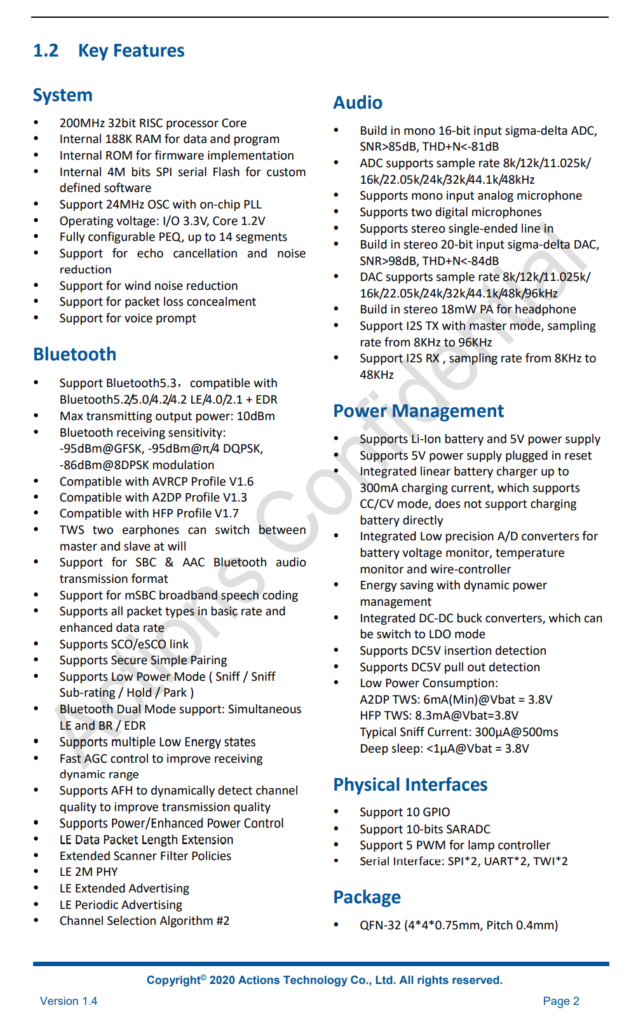
realme Buds Wireless 2 Neo Overview :

- Frequency Response 20Hz-20KHz
- USB Type-C Fast Charging (10mins Charge for 120mins Playback) and up to 17 hours Total Playback (at 50% volume). 11.2mm Dynamic Bass Boost Driver that give deep and punchy bass experience
- Multi-Device Switching with Magnetic Instant Connection that also enables Auto ON/OFF for seamless audio connection
- ENC (Environment Noise Cancellation) for Crystal clear Calls
- IPX4 Water Resistant
Battery side teardown :
There are two Blocks at end end of the device where the electronics are positioned.
both the Blocks were tightly sealed with a waterproof sealant to make it IPX4 water resistant

- right side Block : contains Battery and Battery protection circuit
- Left side Block : contains the Audio-BLE chip, microphone, USB-C, etc..
Right Side Block : (Battery and Protection)
the right side Block contains the Battery, Battery protection IC, a flex PCB underneath the battery to let speaker connections from Left side Block (main PCB) to the Right side earbud speaker




Battery : 3.8Vdc, 150mah, 0.57Wh Lithium Polymer Battery
Battery Protection ic : iCM Chuangxin Micro CM1112-WAE
The CM1112 series two-in-one protection chip is specially designed for the TWS headset charging compartment battery. It has a built-in high-precision voltage detection circuit and a delay circuit. By detecting the voltage and current of the battery, it can protect the battery from overcharge, over-discharge, and overcurrent. .
ICM CM1112 series products are ultra-small and ultra-thin DFN2.2*2.9*0.5mm package, which can achieve ultra-low 1.5uA static working power consumption and 10nA sleep power consumption, and integrate discrete NMOS with built-in ESD protection, which is very suitable for applications Lithium battery protection in TWS headset charging compartments, smart watches and other wearable devices.
According to 52audio, there are already products such as OnePlus Buds Z, OnePlus Buds true wireless earphones, OPPO Enco W31 true wireless earphones and Skullcandy Sesh Small Magic Bean true wireless Bluetooth headphones that have adopted a large number of ICM lithium battery protection ICs.
Source :qucox.com
datasheet :https://www1.iodparts.com/datasheets/icm-2101262238-icm-cm1112-wae-c2685433.pdf
Left Side Block : (Main PCB)

Left side Block contains the following components
- USB-C port for charging
- Volume up, Volume Down, action button
- Indication LEDs
- Audio processing and BLE IC
- Microphone
- Battery charging IC

On the top side of PCB we have Volume buttons and indicator LEDs
On removing the two Holding screws, we can lift the PCB off to get to see the bottom side.

Once screws are removed and PCB is lifted, you will get to see a white colour rubber gasket surrounding the USB-C opening to prevent water from entering the casing.
Once removed, PCB comes out easily.
The Whole PCB is covered with a waterproof silicon layer to prevent circuitry from moisture.

Whole PCB is covered with a thin layer of pink colour water proof coating (seems like silicon coat)
Due to Silicon coating, all labels on the parts are very hard to read, so i have to scratch off all the silicon coat from the parts to see their labels

On the PCB we can see wires going out for Right earbud and battery from the left end of PCB and Wires to Left earbud from right side of PCB
the part labels are hardly visible, I tried to read them by holding the PCB at an angle using Flash and magnifying device.

the above highlighted chip was a Over Voltage and Over Current Protection IC LP5305A from LP semi.
The LP5305A is a highly integrated circuits, it used to protect low voltage system from abnormal high input voltage. The IC continuously check the input voltage, the input current, and the battery voltage. When the protection status is occur, the power MOS will turn off at the same time. The LP5305A is safety devices to ensure worked against accidents.

The features of LP5305A includes
- Under Voltage Lockout (UVLO)
- Input Over Voltage Protection
- Battery Over Voltage Protection
- Over Temperature Protection
- Enable Control
- Over Current Protection
- Fault Flag

the chip right next to the LP5305A is still unknown. any leads would be really appreciable.

the main chip label became a tough thing to read because to scratches i left on it during my bad silicone coat removal job.
Hero of the PCB is ATC3015 from Actions Technology.

Actions Technology ATS3015 is a new generation Bluetooth headset SoC chip. The chip has a built-in 512KB SPI memory for storing user-customized software and a built-in 188KB RAM, eliminating the need for external memory. It uses a 24MHz crystal oscillator and has an on-chip phase-locked loop. The chip uses 1.2V core power supply and 3.3V IO power supply, supports complete preset EQ, supports 14 segments, supports echo cancellation and noise suppression, supports wind noise suppression, supports packet loss concealment and voice prompt functions.
Actions Technology ATS3015 supports Bluetooth 5.3 and is backward compatible with Bluetooth 5.2/5.0/4.2/4.2LE/4.0/2.1 and other Bluetooth specifications. The output power is 10dBm and the receiving sensitivity is -95dBm. Supports TWS binaural applications , supports SBC and AAC audio formats, built-in mono 16-bit ADC, supports two digital microphones, built-in 20-bit stereo DAC, built-in stereo headphone amplifier, a single chip can realize a complete Bluetooth audio application .
Actions Technology’s ATS301X series chips can consume as little as 5.xmA under no-load conditions during regular audio playback, which can extend the use time of the headset; it also supports low-latency mode, and the Bluetooth audio signal delay is as low as 40ms, which improves user experience. User experience when watching videos and playing games.

datasheet : https://edit.wpgdadawant.com/uploads/news_file/blog/2019/87/blog_87_suggest_other_file.pdf

Finally at the end of PCB there is Mems Microphone and supporting circuitry.
we shall discuss many more Teardowns and Embedded systems stuff in upcoming blogs, stay tuned..